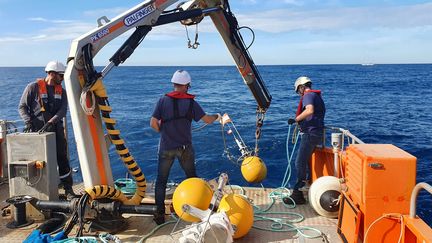French researchers are working to develop devices to locate cetaceans and prevent collisions with ships. A program is currently underway in the Mediterranean.
Whale hunting is not the only threat facing cetaceans. Accidental collisions with ships also contribute to their mortality. To try to locate whales, researchers have submerged microphones in the deep waters off Toulon in the Mediterranean Sea. On board the ship deploying these devices, Thomas Folegot, director of the company Quiet Ocean, oversees the deployment of four prototypes. « The centerpiece of the mooring is the instrumented cage, » he explains. « The entire setup is connected to a hydrophone. It’s like a microphone, but it goes underwater. » The researchers hope to prevent collisions between whales and ships through a program led by WWF France.
The modules are weighted and placed at a depth of 2,000 meters. « Here, we are mainly focusing on the common fin whale, » Thomas Folegot states. « We have assessed that at a distance of ten kilometers, we can detect the animal with an accuracy of 100 meters, which is more than sufficient for collision prevention. »
The mission of these hydrophones is to record the underwater life in the Pelagos Sanctuary, a protected area for marine mammals off the coasts of France and Italy, including Corsica. This zone is also heavily frequented by cruise ships and ferries, as noted by the NGO WWF. « Today, in the Pelagos Sanctuary, collisions with ships are the leading cause of non-natural mortality for large cetaceans such as fin whales and sperm whales, » says Denis Ody, cetacean expert at WWF. « The current estimate of mortality, according to a recent scientific publication, is about 33 common fin whales per year. This jeopardizes the future of the population. »
Currently, the hydrophones are just prototypes, as of October 20, 2024, off the coast of Toulon. It is currently impossible to spot these sperm whales, pilot whales, or other common fin whales in the area. « We don’t have a real optical, laser, or radar system that can detect animals from a ship, » explains Denis Ody. The only solution for now, according to the NGO expert, is to listen for cetaceans, such as the common fin whale, which emits low-frequency sounds. The microphones from the Stop Collision program will be retrieved in a month to test their effectiveness.
Source: francetvinfo



